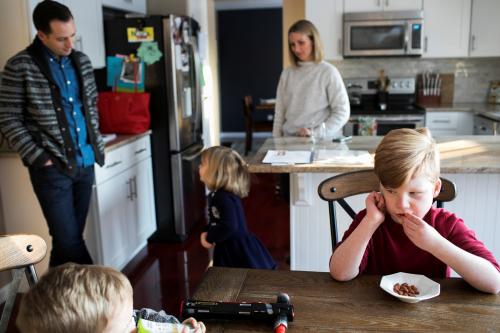The future of America rests in part on how the country prepares the next generation to live and to lead. Childhood is a consequential and cost-effective time to make investments that last a lifetime. Yet, many children in the United States do not have the resources or relationships they need to build a strong foundation for their future.
Since 2019, scholars at the American Enterprise Institute and the Brookings Institution have convened a working group of leading experts to study the challenges and opportunities facing children in America. The members of this working group represent a wide range of academic disciplines, views on the proper roles and effectiveness of government programs, understanding of the current condition of American life, and opinions on how public policy should properly weight competing goods, such as personal responsibility and economic security.
Yet, one area of resounding agreement among this diverse group is the need to rebalance national investments toward children. What follows is a consensus report on our conclusions, laying out actionable policies across a range of policy areas to improve the life of every child in the United States.
One area of resounding agreement among this diverse group is the need to rebalance national investments toward children.
The working group was guided by expertise, evidence, and values, and arrived at consensus through constructive dialogue. While there is broad agreement across academic disciplines and the political spectrum on the need to invest in children, there are substantial tensions resting just beneath the surface. The research base for some policies is mixed and reasonable people disagree about how to interpret and act on the evidence. These disagreements, as well as philosophical differences in how to set priorities, generate division. Through work in consensus-building and compromise, and based on both evidence and shared values, the working group has helped to clarify areas that can garner widespread support.
The working group focused its attention on children ages 12 and younger.1 Across critical domains—household resources, family structure and stability, early development, health, education, and the teenage years—the report presents key facts about the state of childhood in the United States, assembles evidence on policy effectiveness, and establishes a set of priorities for progress.
Every member of the working group has endorsed this report in its entirety and as a whole—meaning support for one idea cannot be separated from any other. This is a consensus document reflecting considerable compromise. No individual group member wholeheartedly supports everything in this report, and in many cases individual members oppose particular items in the report. But all members agree that the recommendations and conclusions in the report, taken as a whole, would improve on the status quo.
The working group agrees that public investment, adequate family income that is based in part on parental employment, and loving relationships in safe and nurturing environments are all critical to ensuring that children have what they need to prosper. The working group agrees that the research evidence indicates that, on average, children are most likely to thrive if they have two parents in the home committed to raising children together, and if the household has sufficient economic resources.
Crucially, the working group supports substantially increasing public investment in children in the context of budget neutrality—in other words, rebalancing existing resources toward children.
I. Priorities for a Healthy and Secure Childhood in America
The following are the key proposals on which the working group found consensus.
The working group supports helping people to be ready for parenthood before they start a family. The group also recognizes that parenting is a key ingredient of children’s healthy development; parenting’s importance is one reason parental mental health is so critical. The working group calls on both government and the nonprofit sector to build more evidence on programs that care for caregivers and offer regular home- and community-based support for parents.
The working group believes that a healthy relationship between a child’s parents is critical to well-being. The most common route to healthy and stable relationships in the United States is through marriage. The working group supports policies to strengthen and encourage marriage along with clear public messages about the importance of marriage.
Addressing the inadequate economic resources that too many families live with is key to improving children’s well-being and reducing hardship they experience. The working group supports increasing resources available to low-income families with families with children through changes to the Child Tax Credit and the Supplemental Nutrition Assistance Program (SNAP). Making the tax credit for children available to households with no earnings and increasing SNAP benefits by 20 percent for families with children ages 5 and younger would reduce child poverty and help children to succeed later in life.
It is critical to ensure that parents have rewarding employment. The working group supports policies that help parents in the acquisition of new skills that lead to better jobs, policies such as those that expand access to apprenticeships, career and technical education, and programs that support parents who are students in the successful completion of their degrees. The working group supports increasing the generosity of the Earned Income Tax Credit as it is a proven pro-work and antipoverty program.
Children should be insulated from economic instability; research suggests that the safety net for children should be strengthened during economic downturns. That safety net includes greater support for out-of-work parents, both to maintain their labor force attachment and to reduce household income volatility. Furthermore, school spending should be protected during economic downturns; letting school spending fall in recessions, and in turn harming children’s education, reflects misaligned budgetary priorities.
The working group recognizes the importance of access to health care and the value of public health insurance for children. It is important to maintain high rates of health insurance coverage, increase participation in prenatal care and well-child visits, and ensure affordable access to doctors. There is progress still to be made to protect children from the lifetime consequences of early exposure to lead, including better screening.
This report argues that families should have access to high-quality and affordable early childhood education and recommends expanding school choice options so that parents can find opportunities that are good matches for their children. The report concludes that there is a strong case for investing more in schools. It recommends support for programs that provide targeted instruction to struggling students. Recognizing the the effect that teachers have on learning, the United States needs to improve its systems for developing skills and improving instruction so that more children have access to excellent classroom teachers. The working group believes that schools and the adults who work in them should be held accountable for student outcomes.
II. Rebalancing the Budget to Invest in Children
The working group proposes, in short, rewriting the generational contract. In 2019, the share of the federal budget spent on children was 9.2 percent and the share spent on the adult portions of Social Security, Medicare, and Medicaid was 45 percent. In 2020, the share of the federal budget spent on children fell to 7.4 percent even as total expenditures on children rose (Hahn et al. 2021). This allocation is a statement of national priorities—priorities that the working group agrees need to change.
The working group proposes, in short, rewriting the generational contract.
How does the working group plan to pay for our proposals? First, the working groups agrees that existing government spending should be rebalanced to focus more on children without adding to the deficit. In other words, the working group proposes that increased spending on programs for children should be financed by redirecting resources away from existing programs currently benefiting wealthier adults.
Increased spending on children should be financed by offsetting new spending with cuts to entitlement programs that benefit upper-middle-class and affluent seniors; so-called corporate welfare, including agriculture subsidies; subsidies to well-off households in the federal tax code; and increased tax enforcement. The working group encourages states and localities to make similar shifts in priorities.
Roughly 40 percent of the federal budget goes to Americans over the age of 65, mainly through Medicare, Social Security, and, to a lesser extent, Medicaid (CBO 2021; Gleckman 2019). Assuming no change in the benefit levels, these payments will make up more than half of the federal budget at some point in the next 10 years. Projected spending on Medicare and Social Security will increase from 7.9 percent of the nation’s total gross domestic product (GDP) today to 10.3 percent of GDP in 2029 (Kogan and Bryant 2019).
Currently, a large share of Medicare and Social Security spending goes to well-off seniors. But older Americans are already in good financial shape by historical standards. Their average net worth has increased more than 50 percent since 1995 (Sawhill and Pulliam 2019). The working group believes that the federal budget can be redirected toward children while still maintaining the most important features of these programs that support older generations.
While official poverty measures suggest that about 13 percent of older adults live in poverty, these numbers do not reflect how they have fared over the past 10 years or how their circumstances compare with those of other groups (Li and Dalaker 2021). Using consumption and income data to assess changes in living standards, research shows that those 65 and older have much lower poverty rates than most other demographic groups and that these rates have fallen sharply over time (Meyer and Sullivan 2012). Few other groups have enjoyed as much improvement in living standards over the past three decades.
Corporate welfare can also be cut in order to direct more resources toward children. Through direct grants and subsidies and special tax expenditures, the United States spends tens of billions of dollars on corporate welfare (Edwards 2017). The largest chunk of this spending is for agriculture subsidies, which increased even more during the pandemic response: 40 percent of farm income in 2020 was from federal subsidies (Lincicome 2020; Rappeport 2020). Farm subsidies go disproportionately to large firms and to high-earning and higher-wealth households (Government Accountability Office 2020).
Finally, the United States spends more than $1.4 trillion per year through the tax code on a variety of deductions and exemptions (US Department of the Treasury 2018), including deductions for state and local tax payments and mortgage interest payments. Almost 60 percent of tax expenditures go to the top 20 percent of the income distribution (Sammartino and Toder 2019). Tax expenditures should be thought of as spending programs administered through the tax code—and some of this existing spending on the well-off should be redirected to children. In addition, the share of taxes that were owed but unpaid is even more disproportionately concentrated among the wealthy: the top 5 percent of households account for about half of unpaid taxes (Sarin 2021). Better tax enforcement would generate revenue to invest in children.
Investments in today’s children will make tomorrow’s adults more economically self-sufficient. Rebalancing federal spending toward children and away from financially-secure elderly adults, the well-off, and special interests, advances the values of promoting economic opportunity, encourages self-sufficiency, and focuses scarce resources where they will do the most good.
III. Rebalancing toward Children in the Context of COVID-19
The COVID-19 pandemic has created new challenges for children that may come with lifelong consequences. While the working group has chosen to build this volume on decades of trends and evidence—all of which held prior to the pandemic and nearly all of which, the group believes, will hold in the years to come—this introduction pauses here to reflect on how the pandemic intersects with this work. The working group is necessarily circumspect, since research is preliminary, conditions on the ground continue to develop, and the future is uncertain.
As of February 2022, an estimated 75 million people in the United States have contracted COVID-19 (Johns Hopkins University 2022), including 9.3 million children ages 17 and younger (Statista 2022). Of the approximately 880,000 deaths in the United States associated with COVID-19 to date, about 750 were children (Centers for Disease Control and Prevention 2022c).
For children and teens, the consequences of the health crisis over the past two years have been much broader than COVID caseloads. By one estimate, more than 167,000 children have lost a caregiver to COVID-19, about 40 percent of whom have lost a parent (Treglia Cutuli, and Arasteh 2021). Changes in routines, missed significant life events, isolation, anxiety, and parental stress all harm children’s mental health. Among adolescents and young adults, especially, these interruptions have occurred amid a broader mental health crisis, with sharply rising rates of depression and suicide over the past decade (Curtin 2020; Twenge 2020). The vast majority of teens report they have been negatively impacted due to the pandemic, with about half of teens reporting they have less motivation to do schoolwork, are less involved in sports, clubs, or extracurricular activities, and are learning less. COVID impacted their physical health as well: according to the CDC, the obesity rate among children rose quickly during the pandemic (Lange et al. 2021).
The closure of schools and child-care facilities affected tens of millions of children; these missed opportunities for academic and social learning are experiences that children cannot make up. By some estimates, nationwide 1.3 million fewer children were enrolled in public schools from pre–K through Grade 12 in 2020–21 than were enrolled in 2018–19 (O’Keefe, Korman, and Dammu 2021). For those who were learning remotely, home learning environments, housing instability, and inaccessible internet and school materials exacerbated inequalities (Van Lancker and Parolin 2020). Student absences, less instructional time, and reduced quality of instruction have all had negative academic consequences: course failures are up and test scores are down (West et al. 2021). Many children will suffer for decades from mental health challenges due to school closures, and will lose tens of thousands of dollars of lifetime earnings due to the time they spent out of the classroom. For low-income children especially, it will be difficult, if not impossible, to make up this lost time. As the world emerges from the pandemic, the country must prioritize investments to improve children’s mental and physical health and make up for lost learning time.
Some aspects of the social policy response to the pandemic point to a way forward for investing in children.
Some aspects of the social policy response to the pandemic point to a way forward for investing in children. Resources were targeted directly to children, including to younger children, through the increased Child Tax Credit and Pandemic Electronic Benefit Transfer (widely known as Pandemic EBT) for missed school meals. In the midst of the crisis, poverty and poverty among children by the supplemental measure has declined (US Census Bureau 2021).
One of the most striking features of the United States’ response to the pandemic was a singular focus on protecting adults from contracting COVID-19, including those who have been vaccinated, with insufficient attention being paid to the needs of children. The working group argues that these priorities are backwards, and that aspects of society’s response to the pandemic prove more than ever that the United States needs to rebalance its priorities toward children.
The working group believes that stability—in resources and relationships—is the foundation for a healthy American childhood. The consensus report that follows builds on decades of peer-reviewed research to describe the condition of American childhood. In general, the working group believes that the COVID-19 pandemic has exposed and intensified preexisting conditions for American children in the domains that this report has prioritized: household resources, family structure and stability, early development, health, education, and the teenage years.
In short, this consensus report sets a path for bringing children safely out of the COVID-19 era and into their future.
Read the full report here.
The Brookings Institution is financed through the support of a diverse array of foundations, corporations, governments, individuals, as well as an endowment. A list of donors can be found in our annual reports published online here. The findings, interpretations, and conclusions in this report are solely those of its author(s) and are not influenced by any donation.
-
Footnotes
- Unless otherwise specified, the words “child” or “children” in this book refer to this age group.
The Brookings Institution is committed to quality, independence, and impact.
We are supported by a diverse array of funders. In line with our values and policies, each Brookings publication represents the sole views of its author(s).






















